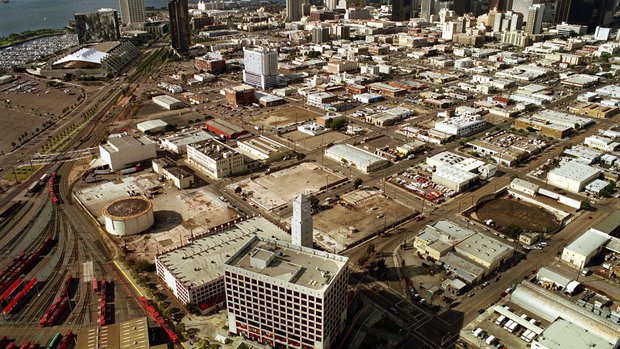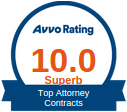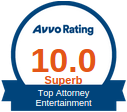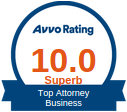By Jeremy M. Evans
Since the World Series and Super Bowl ended in late 2014 and early 2015, the San Diego sports news has been dominated by the San Diego Padres off-season player acquisitions by new General Manager A.J. Preller and whether the San Diego Chargers will have a new stadium in Los Angeles or San Diego. Assuming, for the sake of this article, instead of the Chargers returning to Los Angeles, while the St. Louis Rams and Oakland Raiders move back to Los Angeles, here are some strategies that the Chargers may consider to keep the team in San Diego, and specifically relocating to downtown/East Village, San Diego.
Win Public Opinion & Government Officials Favor to Obtain the Legislation Needed (e.g., bonds/tax hikes)
In the March/April 2004 San Diego Lawyer issue, an article by attorney Michael Fuller, entitled “Biting the Hand that Buys the Tickets,” Fuller makes the point that the Chargers were biting the hand that feeds them (e.g., the fans) by failing to cater to the fan base and win their favor, while trying to get a new stadium deal. The Chargers did this by claiming that they were not making enough money at the current location from ticket sales and other resources and so a move to a new stadium or upgrade was necessary. Proving the claim would prompt a provision in the contract to break the lease with the City of San Diego. The Chargers were not able to prove the claim or break their lease. Among other reasons, the larger Mission Valley master plan with a new Chargers Stadium was introduced, but was eventually scrapped in 2008 because the housing market crashed. (This should sound familiar as the Mission Valley site still has the same land and development issues).
Under the Charger’s current lease with the City of San Diego, the Chargers may leave after each season if they exercise the option before a specified date. This seems to be why the issue has become more prevalent and is so every year (especially in the off-season).
Unfortunately, for the Chargers leadership, their first move this off-season was to take a stand against Mayor Faulconer’s office with conjecture and threats about moving. Their next move was to propose a plan in Carson, California, with archrival and division opponent, the Oakland Raiders, near the home of the Los Angeles Galaxy’s (Major League Soccer) Home Depot Center and paid in excess of $500,000.00 to explore that opportunity and another $500,000.00 to keep the stadium in San Diego. Not two of the greatest public relations moves by the Chargers to win public opinion and government officials favor in opposing a very popular mayor and, while working on a Los Angeles Stadium deal with the Chargers division rival Oakland Raiders.
Also, no knock on the City of Carson, but it is not San Diego, let alone Downtown Los Angeles and the AEG/Farmers Field plan that may still be in the works. The Inglewood plan falls into this category as well. Anyone from Los Angeles can back this statement. That being said, the East Village of San Diego was once a neglected neighborhood only to be changed by the Petco Park area development. There is always promise.
Giving credit where credit is due, the Chargers’ public relations plan did force the hand of the Mayor in getting his advisory task force on the fast track to suggest locations and plans for a redeveloped or new stadium. However, maybe more importantly, the Chargers’ public relations decision cost it public opinion with many Chargers fans. Chargers fans and all San Diegans are the taxpayers who would approve any sort of public bonds, tax hikes, or the like. Threatening a move to another city is not the way to begin or continue a negotiation, let alone run a successful public relations campaign to win support for your team and curry favor(s).
Moreover, proposing a plan to move in with the enemy and division rival Oakland Raiders is not only bad policy, it is also unprecedented. To my knowledge, never before in the history of American professional or collegiate ports have two teams from the same division in the same city shared a stadium. Yes, among other examples, the New York Giants and New York Jets of the National Football League share a stadium in New Jersey, but the Giants play in the NFC East, while the Jets play in the AFC East. Logistically, sharing a stadium would make sense, but no fan wants to call a stadium their own while alternating weekends with a loathed rival.
In contrast, the ’98 San Diego Padres followed the proper public relations model and had a similar lease issue as the Chargers. The Padres ended up with beautiful Petco Park. In “What Petco Park Can Teach Us About a New Chargers Stadium” by Tom Shepard, in the Voice of San Diego, 2/20/2014, Shepard writes: “In 1998, the Padres and City Hall agreed that the Padres could look for a new stadium as [the Chargers requested and were granted an expansion] and close off of Jack Murphy Stadium [now Qualcomm Stadium] with control over all advertising revenue at the stadium . . . [which], made it financially unfeasible for the baseball team to continue using the stadium after its lease expired in 1999.” (Note: Shepard was also the Campaign Chairman for Proposition “C” that funded Petco Park and the East Village redevelopment through public bonds that was eventually passed by San Diego voters).
Prior to the expiration of the lease and prior to any dirt moving (with Petco Park completion coming prior to the start of the 2004 season), the Padres did a brilliant thing within their control. The Padres asked then-Mayor Susan Golding, Shepard writes: “to appoint a citizens task force to validate their claim, and agreed to open their books as part of a review process. After consulting with a variety of experts and reviewing the Padres’ financial statements, the task force confirmed that the Padres’ continued use of what had become Qualcomm Stadium was no longer viable.”
Shepard states it best when he writes: “All told, land acquisition and construction for Petco Park cost $456.8 million: $225 million financed with municipal bonds repaid by hotel taxes; $57.8 million from redevelopment funds generated within the project area; $21 million from the Port of San Diego and $153 million from the Padres (not including their substantial investment in private development projects in East Village).” “A series of lawsuits delayed construction, but Petco Park eventually opened in April 2004. Since then, public investment in it has spurred more than $2 billion in private investment, generating hundreds of millions of dollars in new tax revenues and transforming East Village into one of San Diego’s most exciting and vibrant neighborhoods.”
It did not hurt the Padres that the team made it to the World Series in 1998 losing to the New York Yankees in four games. However, with the Padres seeking the Mayor and City Hall’s guidance and approval first, and more importantly, their involvement, then being transparent by opening their books, then going to the World Series (the luck and opportunity aspect of the equation), it set the stage for what would a 60% approval of the bonds needed to secure the public’s portion of Petco Park approval and the surrounding development.
On the other hand, the ’15 Chargers leadership has demanded a new stadium, refused to open their books, joined the division rival Raiders in a plan to move to a joint stadium in the Los Angeles area, and then pushed the Mayor’s office enough for them to fast track the task force. Where in any of those actions to you see a commitment to the City of San Diego or the fan base? Not to mention, the Chargers leadership is asking taxpayers to subsidize a profitable private entity (at least smile when you take money from our pockets).
Secure the Land needed for Development via Eminent Domain and clear all Environmental Impact Reports with the California Coastal Commission and/or other Government Entities, while Winning the Public Relations Battle
Unfortunately, for the Chargers, the East Village land is not as cheap as it once was before Petco Park arrived. Fortunately, for the Chargers, the land is developed where a downtown stadium could be located. The Chargers can profit immediately with more community expansion planned and to be completed before a proposed stadium completion date in the East Village. As for the Mission Valley site, there have been claims about the underground gas plume on site, crowded freeways, freeway accessibility, with an expansion of housing, office space, and commercial businesses planned. The Mayor’s Task Force recently said a redeveloped Mission Valley site was the best option, but its final recommendation is not due for some time later this year.
Regardless of the site of the new stadium, land will be the main concern of the entire project as the Chargers need land to build a new stadium. (Donald Detisch explains the eminent domain issues in detail (regarding Petco Park) in his article entitled “Private versus Public: Kelo and Eminent Domain,” in the January/February 2006 issue of the San Diego Lawyer magazine). The Chargers would do well by showing its commitment to San Diego to win public support, while working in tandem with City Hall to secure the land needed. One only needs to “Google” the area south of Petco Park to see all of the warehouses, Father Joe’s Village, community housing, the MTS Facility, and a Train Depot to understand the support and money needed to obtain and develop the land. Because the land is near the San Diego Bay, you can be sure the California Coastal Commission and citizen-based groups will be monitoring and possibly challenging the development.
Make the Chargers Stadium about Area Development with San Diegans and Visitors as the Beneficiaries
The Chargers need to focus on development of the area as a whole. By building in the East Village, the Chargers will connect to the Barrio Logan and Logan Heights communities. The Padres did this beautifully when connecting the Gaslamp to the East Village. As a small project for you, please “Google” “East Village San Diego 1998” and click “Images.” See the difference between San Diego 1998-2004 versus San Diego 2004-present. Mind-boggling.
Case-in-point: Tom Shepard, who was mentioned earlier in this article, provided the campaign slogan: “It’s more than a ballpark.” As written in “5 Lessons from the Padres’ Stadium Push” by Lisa Halverstadt, in the Voice of San Diego, 3/18/2014, “The message shifted reluctant voters’ attitudes about the proposal,” quoting Shepard. Halverstadt goes on to write that then-Mayor Golding pressed Padres Owner Moores to put on a new hat, one of developer.
Halverstadt concludes: “The final proposal . . . called for the Padres to sink at least $115 million into the new ballpark plus other redevelopment projects and ensure hundreds of millions more in private investment, including hundreds of hotel rooms that would help the city recoup its investment . . . The area is now home to more than 950 hotel rooms, 3,727 housing units and hundreds of thousands of square feet of retail and commercial space, U-T San Diego reported last year.”
Legal Challenges the Chargers face in 2015 and beyond that the Padres did not in 1998-2004
For one, President Barrack Obama has proposed to outlaw tax-free bonds for professional sports team owners who want new stadiums. This is not yet law, and with Congress and the President not agreeing on much these days, this proposal is unlikely to pass the House and reach the President’s desk. However, it is something that sports teams owners like the Chargers may consider as a possibility. (See “Is Obama proposal the end of taxpayer-subsidized sports stadiums?” by Elaine S. Povich, Pew/Stateline Staff Writer, on USA Today, 3/16/2015). Maybe this was Chargers owner Dean Spanos reasoning for going public with the City of Carson plans—the sense of urgency.
Second, the hotel tax that was used to pay back the tax-free bonds to build Petco Park and the surrounding area may have been dealt a related blow for similar ventures in the future. In August 2014, the Fourth District Court of Appeals, which hears appellate matters in San Diego, reversed a 2013 ruling by Superior Court Judge Ronald Prager that approved a hotel room tax to be used to finance the $520-million expansion. The Court said that the tax was voted on by hoteliers, not by voters, which violated the state constitution and the City Charter. (See “Court Rejects San Diego Convention Center Expansion Tax” by Mark Sauer, Claire Trageser, on KBPS.com, 8/1/2014).
Then again, the Padres sought citywide approval for their tax-free bonds paid back by a hotel tax, so this narrow ruling may not apply to a possible Chargers plan for public bonds paid back by a hotel tax. However, the timetable has been expedited by the emergence of three NFL teams making noise about moving to Los Angeles, while the NFL spokesperson recently said a November ballot vote on a bond/tax hike would take too long. New England Patriots Owner Robert Kraft was quoted as saying that he expects two teams in Los Angeles by 2016. Kraft sits on the committee for team relocation. (See “Kraft: Potential L.A. teams should move together” by Conor Orr, Around The NFL Writer, on NFL.com, 3/23/2015). These circumstances may mean the Chargers might be tempted to circumvent a citywide vote in order to the close the deal for a new stadium. It may also mean that the Chargers are headed back to Los Angeles, from whence they hail.
Tom Shepard, in his previously mentioned article, writes, “Much has changed since 1998, including the demise of redevelopment in California, the Great Recession and a growing skepticism about the city’s ability to manage its finances.” Altogether, maybe there are more challenges for the Chargers today then the Padres faced in 1998-2004 when proposing and building Petco Park. However, the Chargers would be wise to heed the example of the Padres in communicating with the fans and working with public officials to get the deal done.
In Closing
Getting personal: in 2001 and 2002, several friends of mine from the north Los Angeles County area, Palmdale, California, were about to graduate from the Marine Corps Recruiting Depot in San Diego, California, after completing boot camp. Before the graduation, the driving party got lost in downtown while proceeding south on the 163 Freeway via the 15 Freeway (no Google maps in 2001-2002). After seeing the downtown area during that time, I remember mumbling to myself “I would never live downtown, wow!” It is now 2015, and I have lived in downtown San Diego since 2008.
What a ballpark can do and what the Chargers can learn from the Padres leadership that led the effort to make the ballpark a reality!
For a complete breakdown on the legal issues facing owners and cities wanting stadium redevelopment, check out the comprehensive articles in the January/February 2003 issue of the San Diego Lawyer magazine under “The Stadium: All Things Legal” by various authors for a history of the stadium and what it takes to get a deal done.
About the author: Jeremy Evans is the Managing Attorney at California Sports Lawyer. He can be reached at Jeremy@CSLlegal.com.
© California Sports Lawyer





